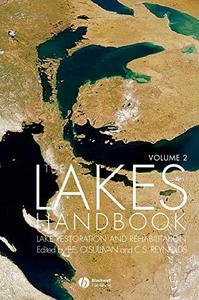 The Lakes Handbook, Volume 2: Lake Restoration and Rehabilitation By
The Lakes Handbook, Volume 2: Lake Restoration and Rehabilitation By2004 | 560 Pages | ISBN: 063204795X | PDF | 7 MB
Continuing concern about water supply and quality, ecosystem sustainability and restoration demands that the modern approach to the management of lakes and reservoirs should be based on a sound understanding of the application of the scientific and ecological principles that underlie freshwater processes. The Lakes Handbook provides an up-to-date overview of the application of ecologically sound approaches, methods and tools using experience gained around the world for an understanding of lakes and their management. Volume one of the Handbook addresses the physical and biological aspects of lakes pertinent to lake management, emphasising those aspects particularly relevant to large, still bodies of water. Volume two then considers lake management, with particular emphasis on sustainability, restoration and rehabilitation.This handbook will be invaluable to ecologists, environmental scientists, physical geographers and hydrologists involved in limnological research, as well as advanced undergraduate and graduate students looking for authoritative reviews of the key areas of limnological study.Content: Chapter 1 On the value of lakes (pages 3-24): Patrick O'SullivanChapter 2 The Assault on the Quality and Value of Lakes (pages 25-61): Wilhelm Ripl and Klaus?Dieter WolterChapter 3 The North American Great Lakes: A Laurentian Great Lakes Focus (pages 65-95): Marlene S. EvansChapter 4 Lake Washington (pages 96-116): W. T. EdmondsonChapter 5 Lakes of Northern Europe (pages 117-158): Heikki Simola and Lauri ArvolaChapter 6 European Alpine Lakes (pages 159-178): Martin T. DokulilChapter 7 Lake Baikal and Other Great Lakes of Asia (pages 179-199): Lyudmila G. ButorinaChapter 8 Lakes in Arid Environments (pages 200-240): W. D. WilliamsChapter 9 Floodplain Lakes and Reservoirs in Tropical and Subtropical South America: Limnology and Human Impacts (pages 241-257): John M. MelackChapter 10 Eutrophication of Shallow Temperate Lakes (pages 261-278): G. L. PhillipsChapter 11 Eutrophication of Shallow Tropical Lakes (pages 279-299): Patrick L. OsborneChapter 12 Reservoirs and Other Artificial Water Bodies (pages 300-327): Milan StraskrabaChapter 13 The Export Coefficient Approach to Prediction of Nutrient Loadings: Errors and Uncertainties in the British Experience (pages 331-353): Helen M. WilsonChapter 14 The Phosphorus Loading Concept and the Oecd Eutrophication Programme: Origin, Application and Capabilities (pages 354-385): Walter Rast and Jeffrey A. ThorntonChapter 15 Models of Lakes and Reservoirs (pages 386-437): Sven?Erik JorgensenChapter 16 The Assessment, Management and Reversal of Eutrophication (pages 438-461): Helmut KlapperChapter 17 Biomanipulation in Shallow Lakes: Concepts, Case Studies and Perspectives (pages 462-482): S. Harry Hosper, Marie?Louise Meijer, R. D. Gulati and Ellen van DonkChapter 18 Restoring Acidified Lakes: An Overview (pages 483-497): Lennart Henrikson, Atle Hindar and Ingemar AbrahamssonChapter 19 The Framework for Managing Lakes in the USA (pages 501-510): Thomas DavenportChapter 20 Nordic Lakes ?Water Legislation with Respect to Lakes in Finland and Sweden (pages 511-522): Marianne LindstromChapter 21 The Problem of Rehabilitating Lakes and Wetlands in Developing Countries: The Case Example of East Africa (pages 523-533): F.W. B. BugenyiChapter 22 South Africa ?Towards Protecting our Lakes (pages 534-542): G. I. Cowan



![S.T.A.L.K.E.R. 2 / STALKER 2: Heart of Chornobyl - Ultimate Edition (2024) [+UPDATE 23.12.2024 - v1.1.3] ElAmigos / Polska wersja językowa](https://i.postimg.cc/Zqd8RWGY/UZG8PBE.jpg)



















































![David Gilmour - Luck and Strange (2024) [FLAC]](https://i.imgur.com/everaBc.jpeg)
![Męskie Granie Orkiestra - Męskie Granie 2024 (2024) [FLAC]](https://i.imgur.com/FAyOxrM.jpeg)
![The Rolling Stones - Hackney Diamonds (2023) [FLAC]](https://i.imgur.com/wCkyyUN.jpg)
![Lady Gaga - Harlequin (2024) [FLAC]](https://i.imgur.com/dcgIA8D.jpeg)
![Natalia Kukulska - Dobrostan (2024) [FLAC]](https://i.imgur.com/bdljG3O.jpeg)
![Kaśka Sochacka - Ta druga (2024) [FLAC]](https://i.imgur.com/hORQKvn.jpeg)
![Kuba Sienkiewicz - Pani Bóg (2024) [FLAC]](https://i.imgur.com/qijCx8Z.jpeg)
![Lanberry - Heca (2024) [FLAC]](https://i.imgur.com/8P7QfeR.jpeg)
![Sara James - PLAYHOUSE (2024) [FLAC]](https://i.imgur.com/m4f8OKg.jpeg)
![Grzegorz Hyży - EPILOG (2024) [FLAC]](https://i.imgur.com/8DA2sBr.jpeg)
![Myslovitz - WIECZORAMI CHŁOPCY WYCHODZĄ NA ULICE (2024) [FLAC]](https://i.imgur.com/l9mMtIG.jpeg)
![Krzysztof Zalewski - ZGŁOWY (2024) [FLAC]](https://i.imgur.com/vh48RAc.jpeg)
![Krzysztof Cugowski - Wiek to tylko liczba (2024) [FLAC]](https://i.imgur.com/SBzgqe2.jpeg)
![Nosowska - Kasia i Błażej (2024) [FLAC]](https://i.imgur.com/mObvVXQ.jpeg)
![sanah - Pianinkowe Kaprysy (2024) [FLAC]](https://i.imgur.com/pVjjPAa.jpeg)
![Kwiat Jabłoni - Pokaz slajdów (2023) [FLAC]](https://i.imgur.com/diERHfZ.jpg)
![Robert Cichy - Spacer po Warszawie (2024) [FLAC]](https://i.imgur.com/ixleU9o.jpeg)
![Viki Gabor - Terminal 3 (2024) [FLAC]](https://i.imgur.com/Q1KCnDs.jpeg)
![Sanah - Kaprysy (2024) [FLAC]](https://i.imgur.com/71OZm4h.jpeg)
![Męskie Granie Orkiestra - Męskie Granie 2023 (2023) [FLAC]](https://i.imgur.com/U4YHo8d.jpg)




